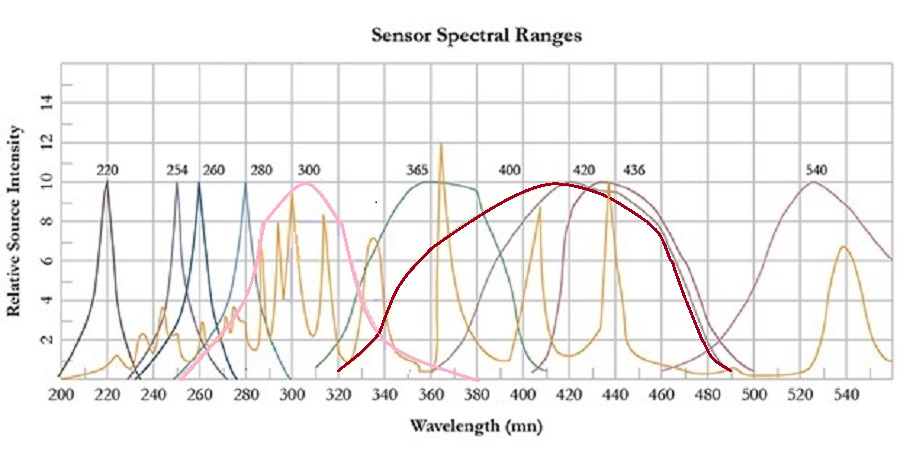UV Light Meter
Applications include:
Medical, Area Exposures, Photolithography, Scanners, Steppers
Light Meter Features
- ±3% NIST Calibration Accuracy to 3 Sigma
- 1% linearity over dynamic range
- Cosine Response Probes
- Real Time Measurements
- Probe wavelengths are available from 173nm through 540nm into the infrared spectrum.
- Interchangeable Probes – Less than 1% Probe to Probe Repeatability
- Measures mw/cm2 , mj/cm2 , accumulated mj/cm2 , time (MS), and accumulated time
- Calculates average value, % uniformity, % deviation from center value, and more
- Calculates 3 Sigma deviation for multiple readings at shutter openings.
- Backlit display makes reading easy in any light
- Battery operates for approximately 18 hours before recharge
- Charger operates from 90-240 VAC, 47-63 Hz with UL, CE, and TUV approvals
A Diverse Light Measurement Instrument
The Model 410 is a measurement instrument with diverse capabilities. A built in computer allows the Model 410 to store sensor readings and calculate average values, percent deviations and other data values. This capability saves you from writing down values and doing calculations to get source uniformity or exposure consistency. Also, the Model 410 computer interface allows stored data to be transfer to permanent storage. The large display format (4×20 characters) gives space for many readings to be viewed at one time.
To make measurements less complicated, the Model 410 is programmed for a variety of operation modes. This allows for a selection of a mode which best suits the data you want to take. The Model 410 will be programmed for the mode sets that best suit the measurements needed.
This means, if you are doing large area uniformity measurements, you will have average value, percent uniformity, and deviation from center value, but you will not have standard deviation of calculations of four sets of millijoule exposures.
The simple format allows you to select the mode that gives you the results you want and then lets the machine do the work. Data review is simple with single button prompts to move back and forward through data results.
UV Light Meter Accessories
A variety of sensor packages are available to use with the Model 410 to measure exposure tools as follows: Nikon, Ultratek, Perkin Elmer, Karl Suss, ABM, OAI, and more. Probe wavelengths are available from 173nm through 540nm into the infrared spectrum.
A rechargeable battery makes the unit very portable. The battery will operate for approximately 18 hours before recharge is needed. Recharge overnight (actual time is 6 hours). You can recharge and operate at the same time, but charging will take much longer. The charger will operate from 90-240 VAC, 47 to 63 Hz and has UL, CE, and TUV approvals.
Light Meter Model 410 Specifications – Area Exposure Machines |
||
| Switch Functions: |
|
|
| Display: |
|
|
| Range: |
|
|
| Mode Selection: | Mode 1: |
|
| Mode 2: |
|
|
| Mode 3: |
|
|
| Mode 4: |
|
|
| Mode 6: |
|
|
| Power: |
|
|
| Probe Wavelengths: | <220nm to 540nm and more> | |
| Size: | 5 3/4 L (146mm) x 8 1/4 (210mm) x 2 H (51mm) Weight | |
Mode 2 and Mode 4 have an additional capability to measure five (5) points as well as nine (9) points. The pattern used for five points is #1 center, #2 straight up (12 o’clock), and #3 left of center (9 o’clock), and #4 straight down (6 o’clock) and #5 right of center (3 o’clock). When the fifth reading is taken then the word ‘CALC’ shows up on the display. Press the ‘CALC’ button and the ‘More’ button and the % deviation of each reading from reading #1 will be displayed. In reading nine points, ignore the ‘CALC’ selection.
Note #1: When the battery symbol comes on next to the ‘RST’ (reset) on the display, then plug in the charger to continue operating the Model 410. The time left on the battery is 30 minutes maximum.
Note #2: The circular counter clockwise pattern is #1 center with #2 position straight up at 12 o’clock with number rotation counter clockwise at 45 degree increments 3 through 9. The linear pattern is #1 center position, #2 upper left, #3 upper center, #4 upper right, #5 left center, center, #6 right center, #7 lower left, #8 lower center and #9 lower right.
Note #3: Uniformity is calculated using the following formula:
Max reading – Min reading x 100 = +/-%
Max reading + Min reading
This graph accurately represents the spectral response of probes used today in the Microelectronic Industry. This graph includes the spectral response of the detector as well as the spectral response of the filter glass used in probes.
